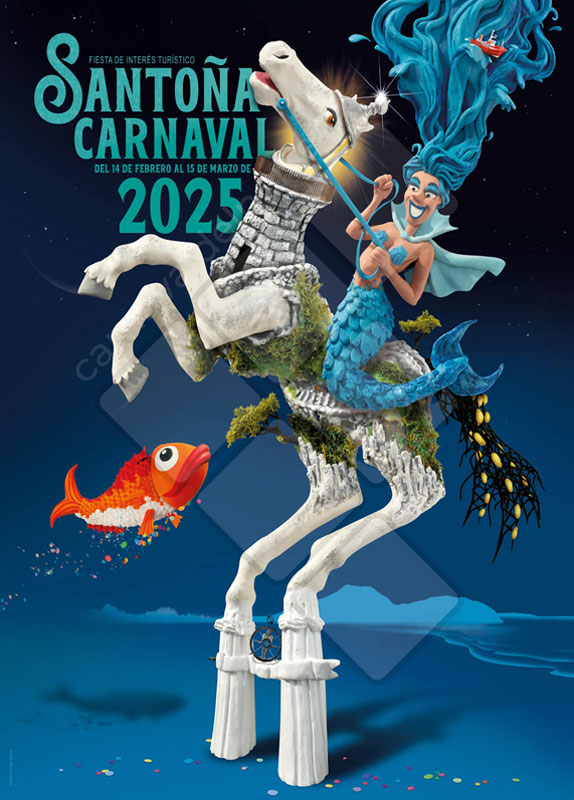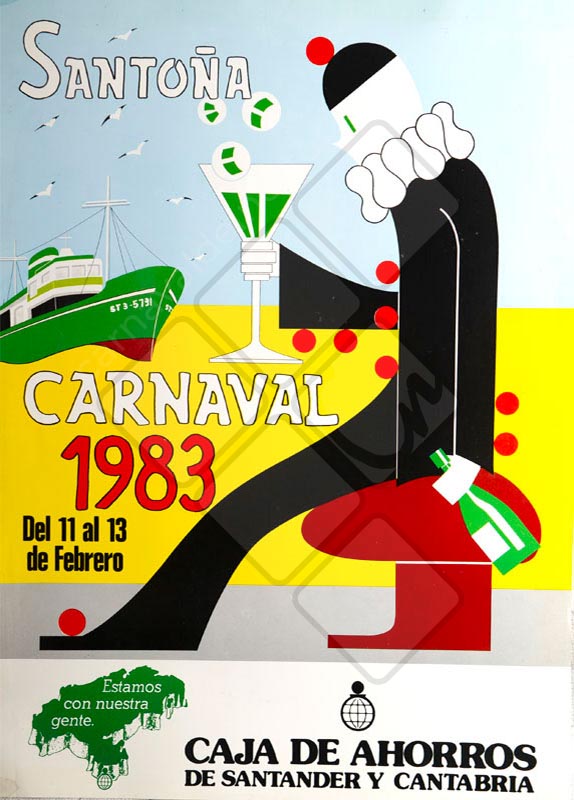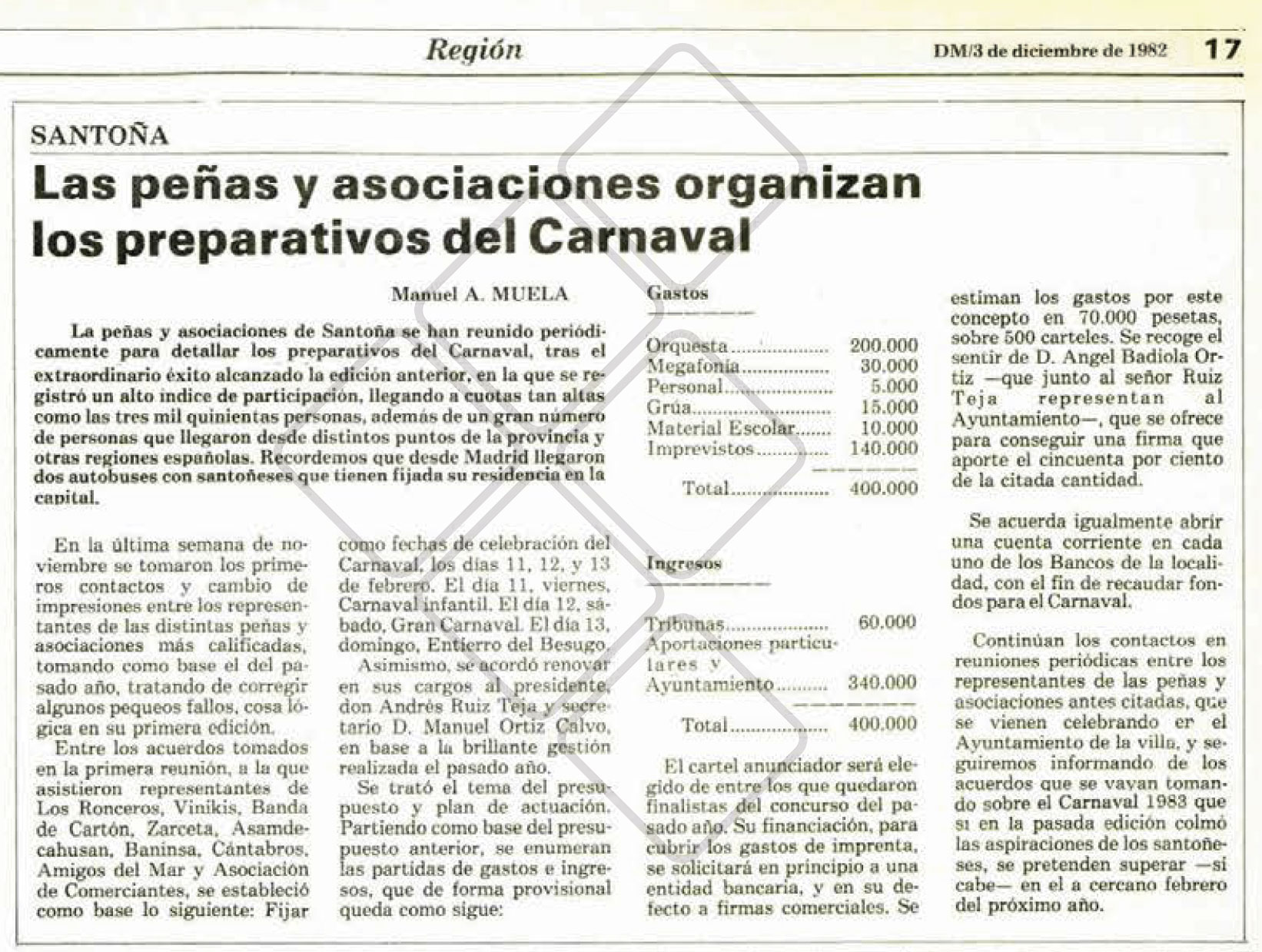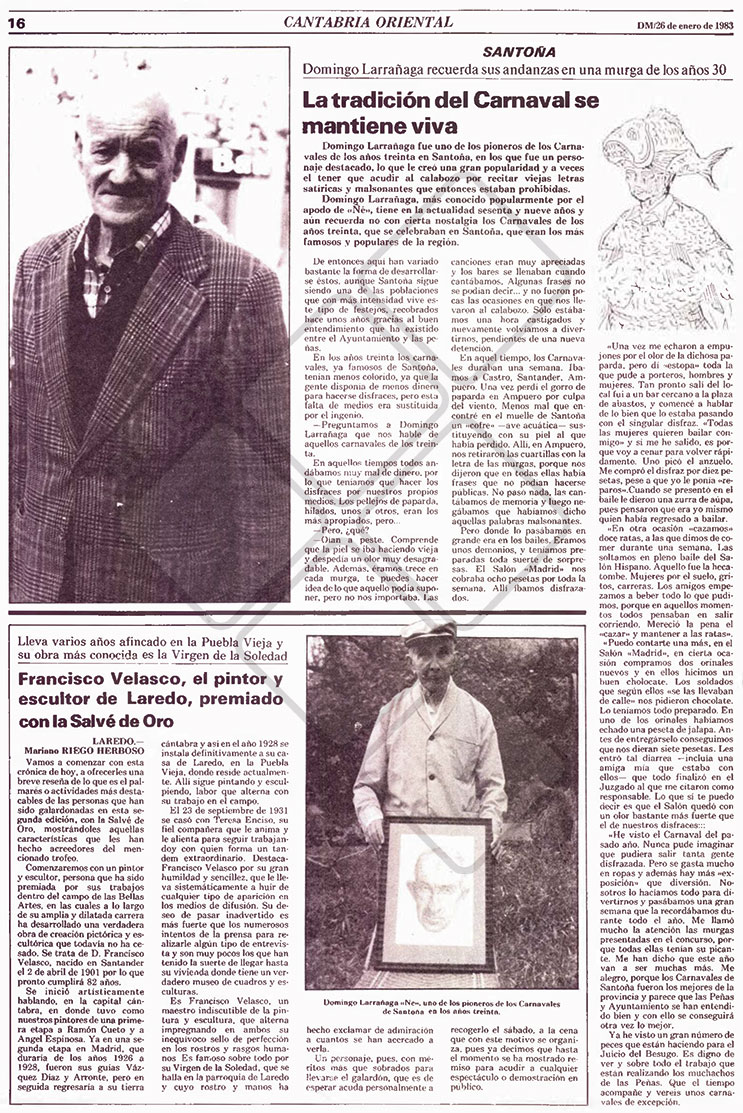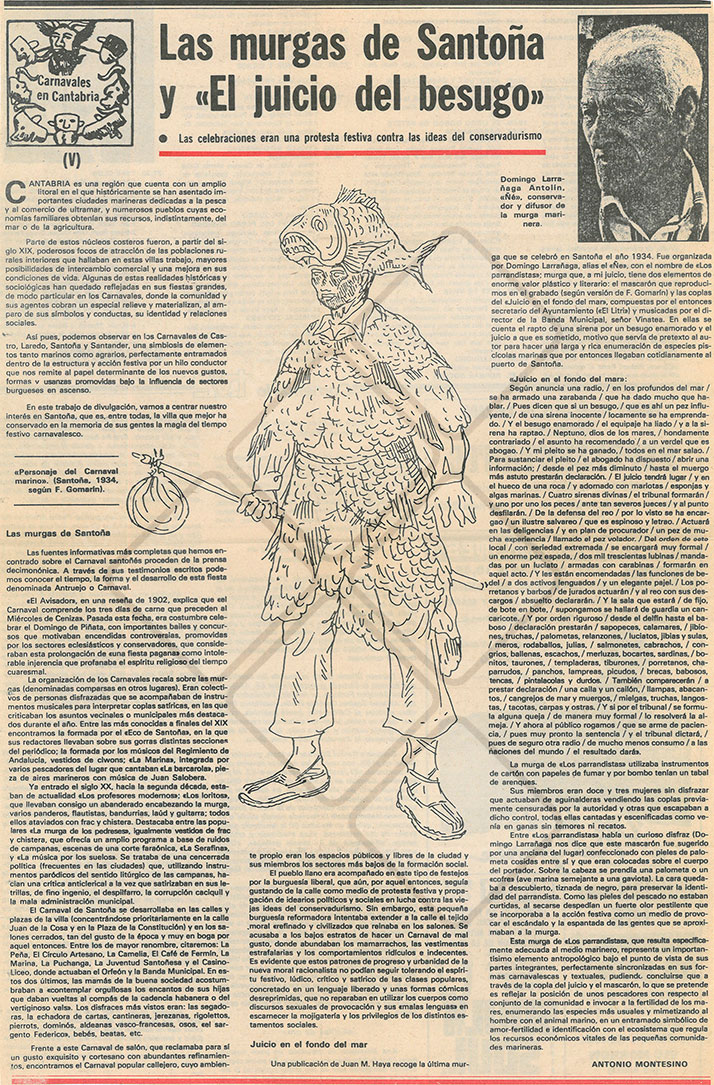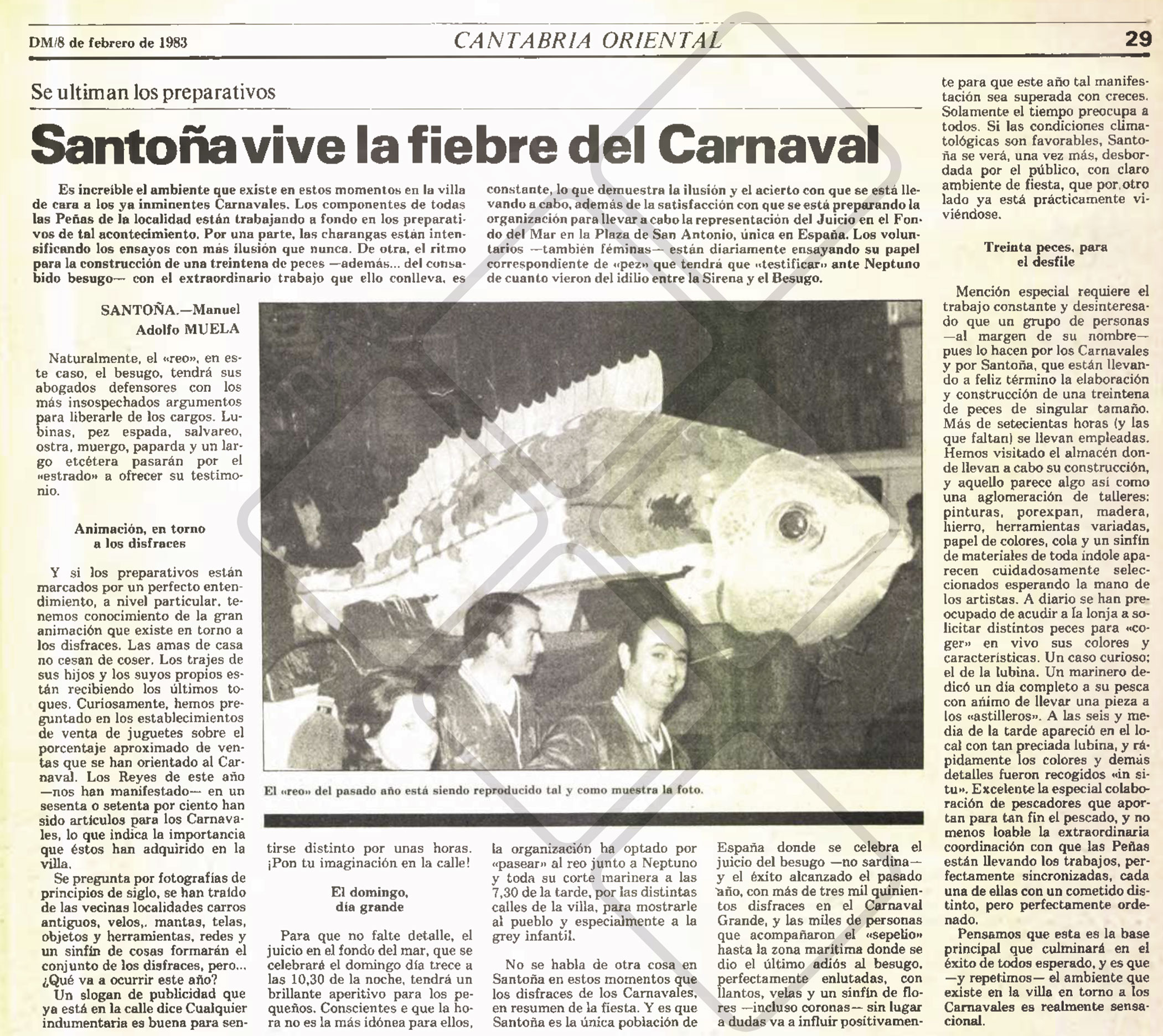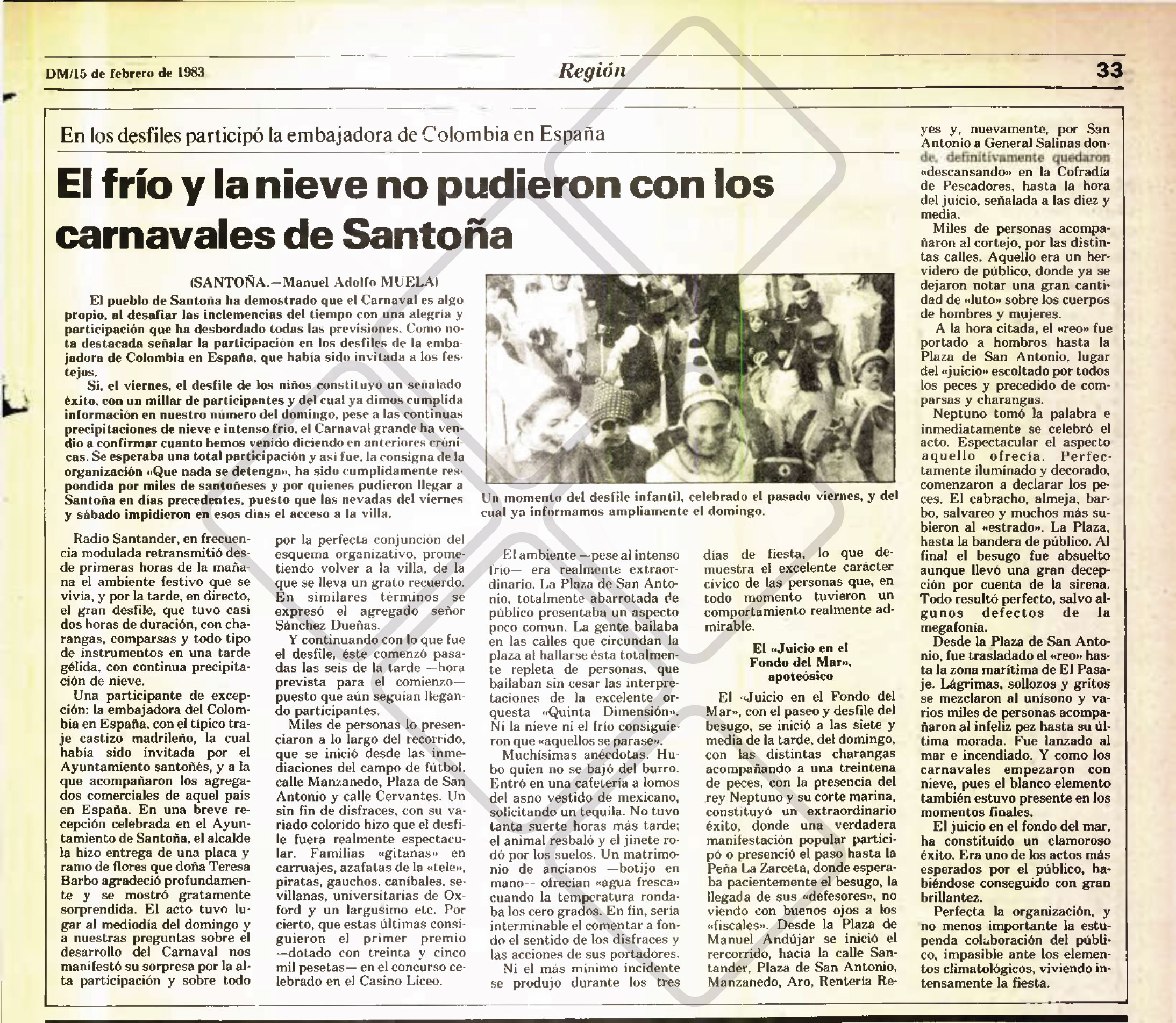"...Celebrating carnival in Rio de Janeiro with sun and 40º is something normal; doing it in Santoña with snow and subzero temperatures is not so common..."
Carnival history 1983
If in 1981 the Carnival of Santoña represented the resurgence of a popular festival deeply rooted in the town for centuries, and in 1982 the path to follow was outlined, giving the event a broader format, the Carnival of 1983 would mark the definitive consolidation of this maritime celebration as one of the festive references throughout Cantabria.
By the end of 1982, the Pro-Carnival Committee was preparing to resume meetings and begin planning the upcoming carnival. The Carnival of 1982 had been a resounding success, which filled all the groups and associations within the committee with enthusiasm. After sharing impressions about the previous edition and discussing possible improvements, one of the first agreements reached was to define the dates for the Carnival of Santoña 1983, which would take place from February 11 to 13, maintaining the same format as the previous year.
-. Friday, February 11: "Children's Day."
-. Saturday, February 12: "Grand Carnival."
-. Sunday, February 13: "Trial at the Bottom of the Sea and Burial of the Besugo."
The regional press closely followed all the preparations the Pro-Carnival Committee was making for the Carnival of Santoña, as reflected by Manuel Adolfo Muela in El Diario Montañés on December 17, 1982.
"The groups and associations organize the preparations for the Carnival."
The groups and associations of Santoña have been meeting periodically to finalize the preparations for the Carnival, following the extraordinary success achieved in the previous edition, which registered a high participation rate. Figures as high as three thousand five hundred people were reached, in addition to a notable number of visitors from various parts of the province and other regions of Spain. It is worth noting that two buses filled with Santoñeses residing in the capital came from Madrid, demonstrating the appeal and rooting of this festival within the community.
In another agreement made by the committee, it was stated that "...the announcing poster would be chosen from among the finalists of last year's contest....," which again fell to Santoñese Manuel Castaño Paltré.
It was also highlighted that the committee agreed to "...open an account at each of the local banks to raise funds for the carnival...."
With an initial budget of 400,000 pesetas, referencing the previous year’s budget, the aspiration was for the Carnival of 1983 to exceed all expectations, just as the Carnival of 1982 had done.
"Santoña finalizes its traditional carnivals."
The Pro-Carnival Committee, in subsequent meetings, sought ingenious formulas to generate income, organizing raffles, "operation duro," and everything imaginable to try to reach the half a million pesetas needed for the basic budget they proposed to cover the carnival's essential needs, although there would also be municipal assistance and collaboration from the Santoña City Council in organizing the events.
It is estimated that about 5,000 people would participate in costumes, and the musical groups and bands would bring the joyful touch along with the orchestras that were already planned.
While modern carnivals continue their course and write their own history, the press continues to remember the old carnivals and focuses its interviews on Domingo Larrañaga "Ñe," who, as mentioned in previous chapters, was one of the members of "Los Parrandistas" and authors of the murga "The Trial at the Bottom of the Sea."
In these interviews, Domingo Larrañaga shares his memories of the Santoña carnivals in the 1930s. Although resources were limited at that time, creativity compensated for the lack of means. Costumes were often made from materials like fish skins, which generated a strong odor, but the fun prevailed over the discomforts.
Domingo recounts how the murgas were very much appreciated, despite some of their songs containing inappropriate phrases that sometimes landed them in jail. He also shares funny anecdotes, such as when they released rats at a dance or tricked soldiers with urinals, situations that ended in chaos and laughter.
Comparing to the current carnivals, Domingo mentions that now much more is spent on costumes and there is less genuine fun, although he celebrates the resurgence of the event thanks to the understanding between the groups and the City Council, which promises that Santoña will again have the best carnivals in the region. He also highlights the preparation for the Trial of the Besugo, anticipating exceptional carnivals.
In the days leading up to Carnival 1983, all preparations were intensifying to be ready for Friday, February 11. The press reported how "Santoña lives the Carnival fever" and how the local groups were working hard on preparations, with bands rehearsing and people constructing fish figures, including the emblematic besugo, which would play a central role in the "Trial at the Bottom of the Sea" event. This unique spectacle, which involves volunteers performing different roles, would culminate with the trial of the besugo, accused of its romance with a mermaid. The community was also preparing with elaborate costumes, and there was great anticipation, especially to surpass the success of the previous year when thousands participated in the Carnival and the symbolic burial of the besugo.
The festive atmosphere was already palpable in the town, and the dedication of the residents and fishermen was notable in the preparations, which included the precise recreation of different marine species. This year was expected to be even more successful, as long as the weather cooperated, and the event promised to overflow the town with joy and color.
One of the factors that most concerned the organization was the cold and snowstorm that accompanied us in Santoña at that time. Under the slogan "nothing stops, despite the inclement weather," all activities continued as planned.
And the "D" day arrived, and on Friday, February 11, "Children's Day of the Carnival," under intermittent snowfall, about a thousand children, completely unfazed by the weather conditions, hit the streets. It was their day, and nothing and no one could prevent them from participating in the joy that their Carnival provided, especially considering that their excitement had already been granted since Reyes, when most of them requested costumes for this festival.
Minutes after six in the afternoon, the various bands from the groups Los Ronceros, Vinikis, Baninsa, and Los Cántabros began their route from Calle Manzanedo to Plaza de San Antonio, Calle Cervantes, Marqués de Robrero, Serna Occina, to return again to San Antonio. Interspersed among the bands, the children participated by 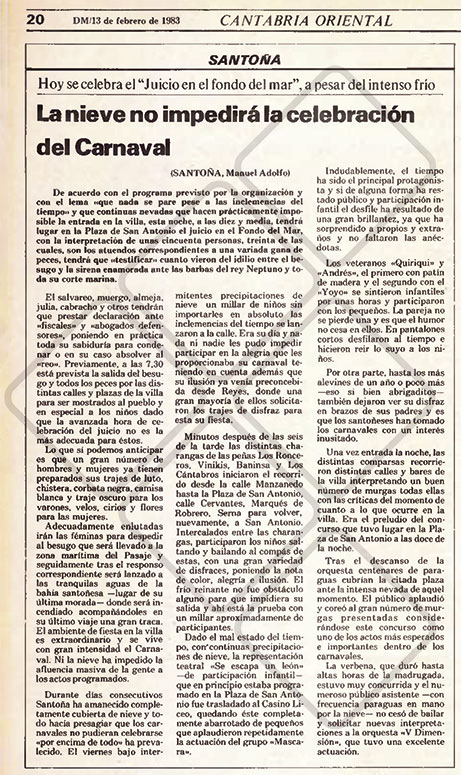 jumping and dancing in sync with them, in a great variety of costumes, adding color, joy, and excitement. The prevailing cold did not deter their outing, and there is proof with approximately a thousand participants.
jumping and dancing in sync with them, in a great variety of costumes, adding color, joy, and excitement. The prevailing cold did not deter their outing, and there is proof with approximately a thousand participants.
On the Grand Carnival day, neither the cold nor the snow could stop the carnivals of Santoña. Radio Santander, on FM, broadcasted the festive atmosphere from the early morning hours, and in the afternoon, live coverage of the grand parade, which lasted almost two hours, featuring bands, comparsas, and all kinds of instruments, took place on a frigid afternoon with continuous snowfall. An exceptional participant was the Colombian ambassador to Spain, who wore the typical Castilian Madrid outfit. She had been invited by the Santoña City Council, accompanied by her country’s commercial attachés in Spain. In a brief reception at the City Hall, the mayor presented her with a plaque and a bouquet of flowers, a gesture for which Mrs. Teresa Barbo expressed profound gratitude, showing herself pleasantly surprised.
he atmosphere, despite the intense cold, was truly extraordinary. Plaza de San Antonio was packed with people, offering an uncommon sight. People danced in the streets around the square, as it was completely filled with individuals who did not cease to dance to the rhythm of the excellent orchestra "Quinta Dimensión." Neither the snow nor the cold managed to stop the party.
The "Trial at the Bottom of the Sea," with the parade of the besugo, began at seven-thirty in the evening on Sunday, with the various bands accompanying about thirty fish, along with King Neptune and his marine court, constituting an extraordinary success. A true popular manifestation participated in the parade, and thousands accompanied the procession through the different streets. It was a boiling cauldron of people, where a significant amount of "mourning" was already noticeable among men and women. At the appointed time, the "prisoner" was carried on shoulders to Plaza de San Antonio, the place of the "trial," escorted by all the fish and preceded by comparsas and bands.
The trial at the bottom of the sea was a resounding success. It was one of the most anticipated events by the public, achieving great brilliance. The organization was perfect, and no less important was the fantastic collaboration from the public, unflinching in the face of the weather elements, living the party intensely.
In short, the Carnival of 1983 exceeded all expectations, despite the storm that occurred. This edition consolidated our carnival as a reference throughout the region, thanks to an unstoppable popular momentum because the public participation was spectacular. Moreover, it left a reflection: "Celebrating carnival in Rio de Janeiro with sun and 40º is something normal; doing it in Santoña with snow and subzero temperatures is not so common". However, undoubtedly, Santoña is the only town that can celebrate it this way."



